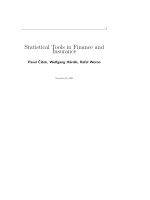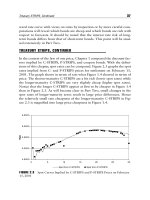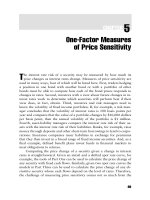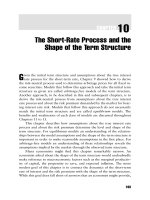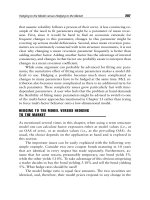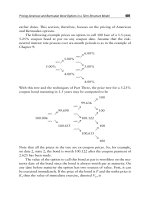Statistical tools for finance and insurance (2nd edition) by weron
Bạn đang xem bản rút gọn của tài liệu. Xem và tải ngay bản đầy đủ của tài liệu tại đây (30.79 MB, 424 trang )
ˇ
Cížek
• Härdle • Weron
(Eds.)
Statistical Tools for Finance and Insurance
ˇ
Pavel Cížek
• Wolfgang Ka rl Härdle • Rafał Weron
(Eds.)
Statistical Tools
for Finance
and Insurance
Second Ed ition
123
Editors
ˇ ížek
Pavel C
Tilburg University
Dept. of Econometrics & OR
P.O. Box 90153
5000 LE Tilburg, Netherlands
Rafał Weron
Wrocław University of Technology
Hugo Steinhaus Center
Wyb. Wyspia´
nskiego 27
50-370 Wrocław, Poland
Prof. Dr. Wolfgang Karl Härdle
Ladislaus von Bortkiewicz Chair of Statistics
C.A.S.E. Centre for Applied Statistics and Economics
School of Business and Economics
Humboldt-Universität zu Berlin
Unter den Linden 6
10099 Berlin, Germany
The majority of chapters have quantlet codes in Matlab or R. These quantlets may be downloaded
from http://ex tras.springer.com directly or via a link on 8 -3 -64 2 -18 061-3
and from www.quantlet.de.
ISBN 978-3-642-18061-3
e-ISBN 978-3-642-18062-0
DOI 10.1007/978-3-642-18062-0
Springer Heidelberg Dordrecht London New York
Library of Congress Control Number: 2011922138
© Springer-Verlag Berlin Heidelberg 2005, 2011
This work is subject to copyright. All rights are reserved, whether the whole or part of the material is
concerned, specifically the rights of translation, reprinting, reuse of illustrations, recitation, broadcasting,
reproduction on microfilm or in any other way, and storage in data banks. Duplication of this publication
or parts thereof is permitted only under the provisions of the German Copyright Law of September 9, 1965,
in its current version, and permission for use must always be obtained from Springer. Violations are
liable to prosecution under the German Copyright Law.
The use of general descriptive names, registered names, trademarks, etc. in this publication does not
imply, even in the absence of a specific statement, that such names are exempt from the relevant protective
laws and regulations and therefore free for general use.
Cover design: WMXDesign GmbH
Printed on acid-free paper
Springer is part of Springer Science+Business Media (www.springer.com)
Contents
Contributors
9
Preface to the second edition
11
Preface
13
Frequently used notation
17
I
19
Finance
1 Models for heavy-tailed asset returns
Szymon Borak, Adam Misiorek, and Rafal Weron
1.1 Introduction . . . . . . . . . . . . . . . . . . . . . . . . . . . . .
1.2 Stable distributions . . . . . . . . . . . . . . . . . . . . . . . . .
1.2.1 Definitions and basic properties . . . . . . . . . . . . . .
1.2.2 Computation of stable density and distribution functions
1.2.3 Simulation of stable variables . . . . . . . . . . . . . . .
1.2.4 Estimation of parameters . . . . . . . . . . . . . . . . .
1.3 Truncated and tempered stable distributions . . . . . . . . . .
1.4 Generalized hyperbolic distributions . . . . . . . . . . . . . . .
1.4.1 Definitions and basic properties . . . . . . . . . . . . . .
1.4.2 Simulation of generalized hyperbolic variables . . . . . .
1.4.3 Estimation of parameters . . . . . . . . . . . . . . . . .
1.5 Empirical evidence . . . . . . . . . . . . . . . . . . . . . . . . .
21
2 Expected shortfall
Simon A. Broda and Marc S. Paolella
2.1 Introduction . . . . . . . . . . . . . . . . . . . . . . . . . . . . .
2.2 Expected shortfall for several asymmetric, fat-tailed distributions
2.2.1 Expected shortfall: definitions and basic results . . . . .
2.2.2 Student’s t and extensions . . . . . . . . . . . . . . . . .
57
21
22
22
25
28
29
34
36
36
40
42
44
57
58
58
60
2
Contents
2.3
2.4
2.5
2.6
2.2.3 ES for the stable Paretian distribution . . . . . . . . . .
2.2.4 Generalized hyperbolic and its special cases . . . . . . .
Mixture distributions . . . . . . . . . . . . . . . . . . . . . . . .
2.3.1 Introduction . . . . . . . . . . . . . . . . . . . . . . . .
2.3.2 Expected shortfall for normal mixture distributions . . .
2.3.3 Symmetric stable mixture . . . . . . . . . . . . . . . . .
2.3.4 Student’s t mixtures . . . . . . . . . . . . . . . . . . . .
Comparison study . . . . . . . . . . . . . . . . . . . . . . . . .
Lower partial moments . . . . . . . . . . . . . . . . . . . . . . .
Expected shortfall for sums . . . . . . . . . . . . . . . . . . . .
2.6.1 Saddlepoint approximation for density and distribution
2.6.2 Saddlepoint approximation for expected shortfall . . . .
2.6.3 Application to sums of skew normal . . . . . . . . . . .
2.6.4 Application to sums of proper generalized hyperbolic . .
2.6.5 Application to sums of normal inverse Gaussian . . . . .
2.6.6 Application to portfolio returns . . . . . . . . . . . . . .
3 Modelling conditional heteroscedasticity in nonstationary series
ˇ ıˇzek
Pavel C´
3.1 Introduction . . . . . . . . . . . . . . . . . . . . . . . . . . . .
3.2 Parametric conditional heteroscedasticity models . . . . . . .
3.2.1 Quasi-maximum likelihood estimation . . . . . . . . .
3.2.2 Estimation results . . . . . . . . . . . . . . . . . . . .
3.3 Time-varying coefficient models . . . . . . . . . . . . . . . . .
3.3.1 Time-varying ARCH models . . . . . . . . . . . . . .
3.3.2 Estimation results . . . . . . . . . . . . . . . . . . . .
3.4 Pointwise adaptive estimation . . . . . . . . . . . . . . . . . .
3.4.1 Search for the longest interval of homogeneity . . . . .
3.4.2 Choice of critical values . . . . . . . . . . . . . . . . .
3.4.3 Estimation results . . . . . . . . . . . . . . . . . . . .
3.5 Adaptive weights smoothing . . . . . . . . . . . . . . . . . . .
3.5.1 The AWS algorithm . . . . . . . . . . . . . . . . . . .
3.5.2 Estimation results . . . . . . . . . . . . . . . . . . . .
3.6 Conclusion . . . . . . . . . . . . . . . . . . . . . . . . . . . .
65
67
70
70
71
72
73
73
76
82
83
84
85
87
90
92
101
.
.
.
.
.
.
.
.
.
.
.
.
.
.
.
101
103
104
105
108
109
111
114
116
118
119
123
124
127
127
4 FX smile in the Heston model
133
Agnieszka Janek, Tino Kluge, Rafal Weron, and Uwe Wystup
4.1 Introduction . . . . . . . . . . . . . . . . . . . . . . . . . . . . . 133
4.2 The model . . . . . . . . . . . . . . . . . . . . . . . . . . . . . . 134
Contents
4.3
4.4
4.5
3
Option pricing . . . . . . . . . . . . . . . . . . . . . . . . . . .
4.3.1 European vanilla FX option prices and Greeks . . . . .
4.3.2 Computational issues . . . . . . . . . . . . . . . . . . .
4.3.3 Behavior of the variance process and the Feller condition
4.3.4 Option pricing by Fourier inversion . . . . . . . . . . . .
Calibration . . . . . . . . . . . . . . . . . . . . . . . . . . . . .
4.4.1 Qualitative effects of changing the parameters . . . . . .
4.4.2 The calibration scheme . . . . . . . . . . . . . . . . . .
4.4.3 Sample calibration results . . . . . . . . . . . . . . . . .
Beyond the Heston model . . . . . . . . . . . . . . . . . . . . .
4.5.1 Time-dependent parameters . . . . . . . . . . . . . . . .
4.5.2 Jump-diffusion models . . . . . . . . . . . . . . . . . . .
5 Pricing of Asian temperature risk
Fred Espen Benth, Wolfgang Karl Hăardle, and Brenda Lopez Cabrera
5.1 The temperature derivative market . . . . . . . . . . . . . . .
5.2 Temperature dynamics . . . . . . . . . . . . . . . . . . . . . .
5.3 Temperature futures pricing . . . . . . . . . . . . . . . . . . .
5.3.1 CAT futures and options . . . . . . . . . . . . . . . .
5.3.2 CDD futures and options . . . . . . . . . . . . . . . .
5.3.3 Infering the market price of temperature risk . . . . .
5.4 Asian temperature derivatives . . . . . . . . . . . . . . . . . .
5.4.1 Asian temperature dynamics . . . . . . . . . . . . . .
5.4.2 Pricing Asian futures . . . . . . . . . . . . . . . . . . .
6 Variance swaps
Wolfgang Karl Hăardle and Elena Silyakova
6.1 Introduction . . . . . . . . . . . . . . . . . . . . . . . . . . .
6.2 Volatility trading with variance swaps . . . . . . . . . . . .
6.3 Replication and hedging of variance swaps . . . . . . . . . .
6.4 Constructing a replication portfolio in practice . . . . . . .
6.5 3G volatility products . . . . . . . . . . . . . . . . . . . . .
6.5.1 Corridor and conditional variance swaps . . . . . . .
6.5.2 Gamma swaps . . . . . . . . . . . . . . . . . . . . .
6.6 Equity correlation (dispersion) trading with variance swaps
6.6.1 Idea of dispersion trading . . . . . . . . . . . . . . .
6.7 Implementation of the dispersion strategy on DAX index .
136
138
140
142
144
149
149
150
152
155
155
158
163
.
.
.
.
.
.
.
.
.
165
167
170
171
173
175
177
177
188
201
.
.
.
.
.
.
.
.
.
.
. 201
. 202
. 203
. 209
. 211
. 213
. 214
. 216
. 216
. 219
4
7 Learning machines supporting bankruptcy prediction
Wolfgang Karl Hăardle, Linda Homann, and Rouslan Moro
7.1 Bankruptcy analysis . . . . . . . . . . . . . . . . .
7.2 Importance of risk classification and Basel II . . .
7.3 Description of data . . . . . . . . . . . . . . . . . .
7.4 Calculations . . . . . . . . . . . . . . . . . . . . . .
7.5 Computational results . . . . . . . . . . . . . . . .
7.6 Conclusions . . . . . . . . . . . . . . . . . . . . . .
Contents
225
.
.
.
.
.
.
8 Distance matrix method for network structure analysis
Janusz Mi´skiewicz
8.1 Introduction . . . . . . . . . . . . . . . . . . . . . . .
8.2 Correlation distance measures . . . . . . . . . . . . .
8.2.1 Manhattan distance . . . . . . . . . . . . . .
8.2.2 Ultrametric distance . . . . . . . . . . . . . .
8.2.3 Noise influence on the time series distance . .
8.2.4 Manhattan distance noise influence . . . . . .
8.2.5 Ultrametric distance noise influence . . . . .
8.2.6 Entropy distance . . . . . . . . . . . . . . . .
8.3 Distance matrices analysis . . . . . . . . . . . . . . .
8.4 Examples . . . . . . . . . . . . . . . . . . . . . . . .
8.4.1 Structure of stock markets . . . . . . . . . . .
8.4.2 Dynamics of the network . . . . . . . . . . .
8.5 Summary . . . . . . . . . . . . . . . . . . . . . . . .
.
.
.
.
.
.
.
.
.
.
.
.
.
.
.
.
.
.
.
.
.
.
.
.
.
.
.
.
.
.
.
.
.
.
.
.
251
.
.
.
.
.
.
.
.
.
.
.
.
.
.
.
.
.
.
.
.
.
.
.
.
.
.
.
.
.
.
.
.
.
.
.
.
.
.
.
.
.
.
.
.
.
.
.
.
.
.
.
.
.
.
.
.
.
.
.
.
.
.
.
.
.
.
.
.
.
.
.
.
.
.
.
.
.
.
II Insurance
9 Building loss models
Krzysztof Burnecki, Joanna Janczura, and Rafal Weron
9.1 Introduction . . . . . . . . . . . . . . . . . . . . . .
9.2 Claim arrival processes . . . . . . . . . . . . . . . .
9.2.1 Homogeneous Poisson process (HPP) . . . .
9.2.2 Non-homogeneous Poisson process (NHPP)
9.2.3 Mixed Poisson process . . . . . . . . . . . .
9.2.4 Renewal process . . . . . . . . . . . . . . .
9.3 Loss distributions . . . . . . . . . . . . . . . . . . .
9.3.1 Empirical distribution function . . . . . . .
9.3.2 Exponential distribution . . . . . . . . . . .
9.3.3 Mixture of exponential distributions . . . .
226
237
238
239
240
245
251
252
253
253
254
255
257
262
263
265
265
268
279
291
293
.
.
.
.
.
.
.
.
.
.
.
.
.
.
.
.
.
.
.
.
.
.
.
.
.
.
.
.
.
.
.
.
.
.
.
.
.
.
.
.
.
.
.
.
.
.
.
.
.
.
.
.
.
.
.
.
.
.
.
.
.
.
.
.
.
.
.
.
.
.
293
294
295
297
300
301
302
303
304
305
Contents
9.4
9.5
5
9.3.4 Gamma distribution . . . . . . . . . . . . . . . . .
9.3.5 Log-Normal distribution . . . . . . . . . . . . . . .
9.3.6 Pareto distribution . . . . . . . . . . . . . . . . . .
9.3.7 Burr distribution . . . . . . . . . . . . . . . . . . .
9.3.8 Weibull distribution . . . . . . . . . . . . . . . . .
Statistical validation techniques . . . . . . . . . . . . . . .
9.4.1 Mean excess function . . . . . . . . . . . . . . . . .
9.4.2 Tests based on the empirical distribution function
Applications . . . . . . . . . . . . . . . . . . . . . . . . . .
9.5.1 Calibration of loss distributions . . . . . . . . . . .
9.5.2 Simulation of risk processes . . . . . . . . . . . . .
10 Ruin probability in finite time
Krzysztof Burnecki and Marek Teuerle
10.1 Introduction . . . . . . . . . . . . . . . . . . . . . . . . .
10.1.1 Light- and heavy-tailed distributions . . . . . . .
10.2 Exact ruin probabilities in finite time . . . . . . . . . . .
10.2.1 Exponential claim amounts . . . . . . . . . . . .
10.3 Approximations of the ruin probability in finite time . .
10.3.1 Monte Carlo method . . . . . . . . . . . . . . . .
10.3.2 Segerdahl normal approximation . . . . . . . . .
10.3.3 Diffusion approximation by Brownian motion . .
10.3.4 Corrected diffusion approximation . . . . . . . .
10.3.5 Diffusion approximation by α-stable L´evy motion
10.3.6 Finite time De Vylder approximation . . . . . .
10.4 Numerical comparison of the finite time approximations
11 Property and casualty insurance pricing with GLMs
Jan Iwanik
11.1 Introduction . . . . . . . . . . . . . . . . . . . . .
11.2 Insurance data used in statistical modeling . . .
11.3 The structure of generalized linear models . . . .
11.3.1 Exponential family of distributions . . . .
11.3.2 The variance and link functions . . . . . .
11.3.3 The iterative algorithm . . . . . . . . . .
11.4 Modeling claim frequency . . . . . . . . . . . . .
11.4.1 Pre-modeling steps . . . . . . . . . . . . .
11.4.2 The Poisson model . . . . . . . . . . . . .
11.4.3 A numerical example . . . . . . . . . . . .
.
.
.
.
.
.
.
.
.
.
.
.
.
.
.
.
.
.
.
.
.
.
. 307
. 309
. 311
. 313
. 314
. 315
. 315
. 318
. 321
. 321
. 324
329
.
.
.
.
.
.
.
.
.
.
.
.
.
.
.
.
.
.
.
.
.
.
.
.
.
.
.
.
.
.
.
.
.
.
.
.
.
.
.
.
.
.
.
.
.
.
.
.
329
331
333
334
334
335
335
337
338
338
340
342
349
.
.
.
.
.
.
.
.
.
.
.
.
.
.
.
.
.
.
.
.
.
.
.
.
.
.
.
.
.
.
.
.
.
.
.
.
.
.
.
.
.
.
.
.
.
.
.
.
.
.
.
.
.
.
.
.
.
.
.
.
.
.
.
.
.
.
.
.
.
.
. 349
. 350
. 351
. 352
. 353
. 353
. 354
. 355
. 355
. 356
6
Contents
11.5 Modeling claim severity . . . . . . . . . . . . . . . .
11.5.1 Data preparation . . . . . . . . . . . . . . . .
11.5.2 A numerical example . . . . . . . . . . . . . .
11.6 Some practical modeling issues . . . . . . . . . . . .
11.6.1 Non-numeric variables and banding . . . . . .
11.6.2 Functional form of the independent variables
11.7 Diagnosing frequency and severity models . . . . . .
11.7.1 Expected value as a function of variance . . .
11.7.2 Deviance residuals . . . . . . . . . . . . . . .
11.7.3 Statistical significance of the coefficients . . .
11.7.4 Uniformity over time . . . . . . . . . . . . . .
11.7.5 Selecting the final models . . . . . . . . . . .
11.8 Finalizing the pricing models . . . . . . . . . . . . .
12 Pricing of catastrophe bonds
Krzysztof Burnecki, Grzegorz Kukla, and David Taylor
12.1 Introduction . . . . . . . . . . . . . . . . . . . . . . .
12.1.1 The emergence of CAT bonds . . . . . . . . .
12.1.2 Insurance securitization . . . . . . . . . . . .
12.1.3 CAT bond pricing methodology . . . . . . . .
12.2 Compound doubly stochastic Poisson pricing model
12.3 Calibration of the pricing model . . . . . . . . . . .
12.4 Dynamics of the CAT bond price . . . . . . . . . . .
.
.
.
.
.
.
.
.
.
.
.
.
.
.
.
.
.
.
.
.
.
.
.
.
.
.
.
.
.
.
.
.
.
.
.
.
.
.
.
.
.
.
.
.
.
.
.
.
.
.
.
.
.
.
.
.
.
.
.
.
.
.
.
.
.
.
.
.
.
.
.
.
.
.
.
.
.
.
356
357
358
360
360
360
361
361
361
363
364
365
366
371
.
.
.
.
.
.
.
.
.
.
.
.
.
.
13 Return distributions of equity-linked retirement plans
Nils Detering, Andreas Weber, and Uwe Wystup
13.1 Introduction . . . . . . . . . . . . . . . . . . . . . . . . .
13.2 The displaced double-exponential jump diffusion model
13.2.1 Model equation . . . . . . . . . . . . . . . . . . .
13.2.2 Drift adjustment . . . . . . . . . . . . . . . . . .
13.2.3 Moments, variance and volatility . . . . . . . . .
13.3 Parameter estimation . . . . . . . . . . . . . . . . . . .
13.3.1 Estimating parameters from financial data . . . .
13.4 Interest rate curve . . . . . . . . . . . . . . . . . . . . .
13.5 Products . . . . . . . . . . . . . . . . . . . . . . . . . . .
13.5.1 Classical insurance strategy . . . . . . . . . . . .
13.5.2 Constant proportion portfolio insurance . . . . .
13.5.3 Stop loss strategy . . . . . . . . . . . . . . . . . .
13.6 Payments to the contract and simulation horizon . . . .
13.7 Cost structures . . . . . . . . . . . . . . . . . . . . . . .
.
.
.
.
.
.
.
.
.
.
.
.
.
.
.
.
.
.
.
.
.
.
.
.
.
.
.
.
371
372
374
375
377
379
381
393
.
.
.
.
.
.
.
.
.
.
.
.
.
.
.
.
.
.
.
.
.
.
.
.
.
.
.
.
.
.
.
.
.
.
.
.
.
.
.
.
.
.
.
.
.
.
.
.
.
.
.
.
.
.
.
.
393
395
395
398
398
399
399
401
401
401
402
404
405
406
Contents
13.8 Results without costs .
13.9 Impact of costs . . . .
13.10Impact of jumps . . .
13.11Summary . . . . . . .
Index
7
.
.
.
.
.
.
.
.
.
.
.
.
.
.
.
.
.
.
.
.
.
.
.
.
.
.
.
.
.
.
.
.
.
.
.
.
.
.
.
.
.
.
.
.
.
.
.
.
.
.
.
.
.
.
.
.
.
.
.
.
.
.
.
.
.
.
.
.
.
.
.
.
.
.
.
.
.
.
.
.
.
.
.
.
.
.
.
.
.
.
.
.
407
409
411
412
415
Contributors
Fred Espen Benth Center of Mathematics for Applications, University of Oslo
Szymon Borak Center for Applied Statistics and Economics, Humboldt-Universităat zu Berlin
Simon Broda Department of Quantitative Economics, Amsterdam School of
Economics
Krzysztof Burnecki Hugo Steinhaus Center for Stochastic Methods, Wroclaw
University of Technology
Brenda Lopez Cabrera Center for Applied Statistics and Economics, Humboldt Universităat zu Berlin
ˇ ıˇ
Pavel C´
zek Center for Economic Research, Tilburg University
Nils Detering MathFinance AG, Waldems, Germany
Wolfgang Karl Hă
ardle Center for Applied Statistics and Economics, Humboldt Universităat zu Berlin and National Central University, Jhongli,
Taiwan
Linda Homann Center for Applied Statistics and Economics, Humboldt Universită
at zu Berlin
Jan Iwanik RBS Insurance, London
Agnieszka Janek Institute of Mathematics and Computer Science, Wroclaw
University of Technology
Joanna Janczura Hugo Steinhaus Center for Stochastic Methods, Wroclaw
University of Technology
Tino Kluge MathFinance AG, Waldems, Germany
Grzegorz Kukla Towarzystwo Ubezpieczeniowe EUROPA S.A., Wroclaw
Adam Misiorek Santander Consumer Bank S.A., Wroclaw
10
Contributors
Janusz Mi´skiewicz Institute of Theoretical Physics, University of Wroclaw
Rouslan Moro Brunel University, London
Marc Paolella Swiss Banking Institute, University of Zurich
Dorothea Schă
afer Deutsches Institut fă
ur Wirtschaftsforschung e.V., Berlin
Elena Silyakova Center for Applied Statistics and Economics, Humboldt Universită
at zu Berlin
David Taylor School of Computational and Applied Mathematics, University
of the Witwatersrand, Johannesburg
Marek Teuerle Institute of Mathematics and Computer Science, Wroclaw University of Technology
Andreas Weber MathFinance AG, Waldems, Germany
Rafal Weron Institute of Organization and Management, Wroclaw University
of Technology
Agnieszka Wyloma´
nska Hugo Steinhaus Center for Stochastic Methods, Wroclaw
University of Technology
Uwe Wystup MathFinance AG, Waldems, Germany
Preface to the second edition
The meltdown of financial assets in the fall of 2008 made the consequences of
financial crisis clearly visible to the broad public. The rapid loss of value of asset
backed securities, collateralized debt obligations and other structured products
was caused by devaluation of complex financial products. We therefore found
it important to revise our book and present up-to-date research in financial
statistics and econometrics.
We have dropped several chapters, thoroughly revised other and added a lot of
new material. In the Finance part, the revised chapter on stable laws (Chapter 1) seamlessly guides the Reader not only through the computationally intensive techniques for stable distributions, but also for tempered stable and
generalized hyperbolic laws. This introductory chapter is now complemented
by a new text on Expected Shortfall with fat-tailed and mixture distributions
(Chapter 2). The book then continues with a new chapter on adaptive heteroscedastic time series modeling (Chapter 3), which smoothly introduces the
Reader to Chapter 4 on stochastic volatility modeling with the Heston model.
The quantitative analysis of new products like weather derivatives and variance
swaps is conducted in two new chapters (5 and 6, respectively). Finally, two
different powerful classification techniques - learning machines for bankruptcy
forecasting and the distance matrix method for market structure analysis - are
discussed in the following two chapters (7 and 8, respectively).
In the Insurance part, two classical chapters on building loss models (Chapter
9) and on ruin probabilities (Chapter 10) are followed by a new text on property
and casualty insurance with GLMs (Chapter 11). We then turn to products
linking the finance and insurance worlds. Pricing of catastrophe bonds is discussed in Chapter 12 and a new chapter introduces into the pricing and cost
structures of equity linked retirement plans (Chapter 13).
12
Preface
The majority of chapters have quantlet codes in Matlab or R. These quantlets
may be downloaded from the Springer.com page or from www.quantlet.de.
Finally, we would like to thank Barbara Choros, Richard Song, and Weining
Wang for their help in the text management.
ˇ zek, Wolfgang Karl Hăardle, and Rafal Weron
Pavel C
Tilburg, Berlin, and Wroclaw, January 2011
Preface
This book is designed for students, researchers and practitioners who want to
be introduced to modern statistical tools applied in finance and insurance. It
is the result of a joint effort of the Center for Economic Research (CentER),
Center for Applied Statistics and Economics (C.A.S.E.) and Hugo Steinhaus
Center for Stochastic Methods (HSC). All three institutions brought in their
specific profiles and created with this book a wide-angle view on and solutions
to up-to-date practical problems.
The text is comprehensible for a graduate student in financial engineering as
well as for an inexperienced newcomer to quantitative finance and insurance
who wants to get a grip on advanced statistical tools applied in these fields. An
experienced reader with a bright knowledge of financial and actuarial mathematics will probably skip some sections but will hopefully enjoy the various
computational tools. Finally, a practitioner might be familiar with some of
the methods. However, the statistical techniques related to modern financial
products, like MBS or CAT bonds, will certainly attract him.
“Statistical Tools for Finance and Insurance” consists naturally of two main
parts. Each part contains chapters with high focus on practical applications.
The book starts with an introduction to stable distributions, which are the standard model for heavy tailed phenomena. Their numerical implementation is
thoroughly discussed and applications to finance are given. The second chapter
presents the ideas of extreme value and copula analysis as applied to multivariate financial data. This topic is extended in the subsequent chapter which
deals with tail dependence, a concept describing the limiting proportion that
one margin exceeds a certain threshold given that the other margin has already
exceeded that threshold. The fourth chapter reviews the market in catastrophe insurance risk, which emerged in order to facilitate the direct transfer of
reinsurance risk associated with natural catastrophes from corporations, insurers, and reinsurers to capital market investors. The next contribution employs
functional data analysis for the estimation of smooth implied volatility surfaces. These surfaces are a result of using an oversimplified market benchmark
model – the Black-Scholes formula – to real data. An attractive approach to
14
Preface
overcome this problem is discussed in chapter six, where implied trinomial trees
are applied to modeling implied volatilities and the corresponding state-price
densities. An alternative route to tackling the implied volatility smile has led
researchers to develop stochastic volatility models. The relative simplicity and
the direct link of model parameters to the market makes Heston’s model very
attractive to front office users. Its application to FX option markets is covered in chapter seven. The following chapter shows how the computational
complexity of stochastic volatility models can be overcome with the help of
the Fast Fourier Transform. In chapter nine the valuation of Mortgage Backed
Securities is discussed. The optimal prepayment policy is obtained via optimal
stopping techniques. It is followed by a very innovative topic of predicting corporate bankruptcy with Support Vector Machines. Chapter eleven presents a
novel approach to money-demand modeling using fuzzy clustering techniques.
The first part of the book closes with productivity analysis for cost and frontier estimation. The nonparametric Data Envelopment Analysis is applied to
efficiency issues of insurance agencies.
The insurance part of the book starts with a chapter on loss distributions. The
basic models for claim severities are introduced and their statistical properties
are thoroughly explained. In chapter fourteen, the methods of simulating and
visualizing the risk process are discussed. This topic is followed by an overview
of the approaches to approximating the ruin probability of an insurer. Both
finite and infinite time approximations are presented. Some of these methods
are extended in chapters sixteen and seventeen, where classical and anomalous
diffusion approximations to ruin probability are discussed and extended to
cases when the risk process exhibits good and bad periods. The last three
chapters are related to one of the most important aspects of the insurance
business – premium calculation. Chapter eighteen introduces the basic concepts
including the pure risk premium and various safety loadings under different
loss distributions. Calculation of a joint premium for a portfolio of insurance
policies in the individual and collective risk models is discussed as well. The
inclusion of deductibles into premium calculation is the topic of the following
contribution. The last chapter of the insurance part deals with setting the
appropriate level of insurance premium within a broader context of business
decisions, including risk transfer through reinsurance and the rate of return on
capital required to ensure solvability.
Our e-book offers a complete PDF version of this text and the corresponding
HTML files with links to algorithms and quantlets. The reader of this book
may therefore easily reconfigure and recalculate all the presented examples
and methods via the enclosed XploRe Quantlet Server (XQS), which is also
Preface
15
available from www.xplore-stat.de and www.quantlet.com. A tutorial chapter
explaining how to setup and use XQS can be found in the third and final part
of the book.
We gratefully acknowledge the support of Deutsche Forschungsgemeinschaft
ă
(SFB 373 Quantikation und Simulation Okonomischer
Prozesse, SFB 649
ă
Okonomisches Risiko) and Komitet Bada´
n Naukowych (PBZ-KBN 016/P03/99
Mathematical models in analysis of financial instruments and markets in
Poland). A book of this kind would not have been possible without the help
of many friends, colleagues, and students. For the technical production of the
e-book platform and quantlets we would like to thank Zdenˇek Hl´
avka, Sigbert
Klinke, Heiko Lehmann, Adam Misiorek, Piotr Uniejewski, Qingwei Wang, and
Rodrigo Witzel. Special thanks for careful proofreading and supervision of the
insurance part go to Krzysztof Burnecki.
zek, Wolfgang Hă
Pavel C
ardle, and Rafal Weron
Tilburg, Berlin, and Wroclaw, February 2005
Frequently used notation
def
x = ...
[x]
x ≈y
A
(F ◦ G)(x)
I
R
an , b n , . . .
αn = O(βn )
αn = o(βn )
x is defined as ...
integer part of x
x is approximately equal to y
transpose of matrix A
F {G(x)} for functions F and G
indicator function
real numbers
sequences of real numbers of vectors
αn /βn −→ const. as n −→ ∞
αn /βn −→ 0 as n −→ ∞
X ∼D
P(A)
E(X)
Var(X)
Cov(X, Y )
N(μ, Σ)
the random variable X has a distribution D
probability of a set A
expected value of random variable X
variance of random variable X
covariance of two random variables X and Y
normal distribution with expectation μ and covariance matrix Σ;
a similar notation is used if Σ is the correlation matrix
standard normal cumulative distribution function
standard normal density function
chi-squared distribution with p degrees of freedom
t-distribution (Student’s) with p degrees of freedom
Wiener process
the information set generated by all information available at time t
sequences of random variables
∀ε > 0 ∃M, ∃N such that P[|An /Bn | > M ] < ε, ∀n > N
∀ε > 0 : limn→∞ P[|An /Bn | > ε] = 0
Φ
ϕ
χ2p
tp
Wt
Ft
An , Bn , . . .
An = Op (Bn )
An = op (Bn )
Part I
Finance
Part II
Insurance
